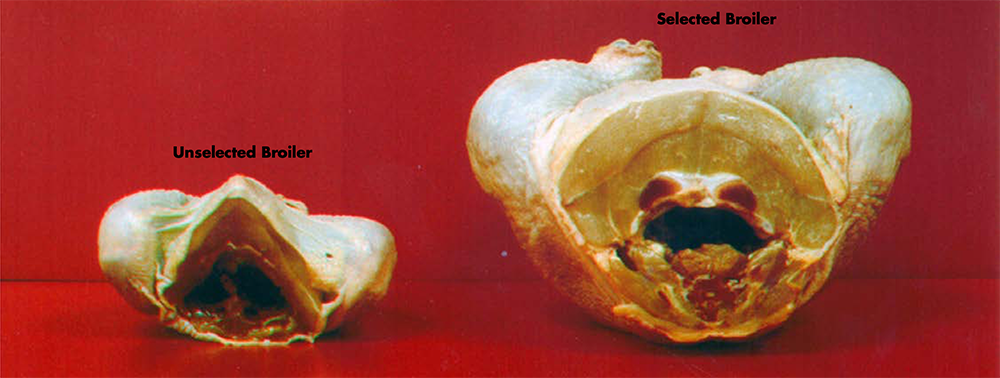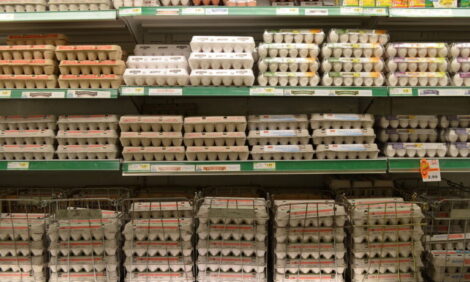



Why the Rapid Growth Rate in Today’s Chickens
Dr Wei Zhai, Assistant Extension/Research Professor, and Jessica Wells, Extension Instructor at the Poultry Science Department of Mississippi State University explain that broiler growth rates have improved significantly over recent decades as the result of better feeding and genetics and without the use of hormones.Two questions people often wonder about poultry are: "Why are chickens grown to such an enormous size in an industry setting?" and "Does the industry use hormones to help the chickens reach this large body size?" These are very good questions. It is true that chickens currently grown in the industry are drastically bigger than those grown years ago. This difference is illustrated in Figure 1.

However, hormones are not the reason for this size difference. Rather, the research and knowledge the industry has gained over the past years has allowed producers to grow larger chickens. In fact, hormone supplementation is illegal and not approved for poultry in the United States. In addition, the cost of such supplementation would far outweigh the value of the chicken, even if it were legal.
The chicken that is bought out of the grocery store comes from birds called broilers. Broilers are strains of birds used in the poultry industry, and their only purpose is to produce a large amount of meat in a short amount of time. If the industry is able to grow a big bird in a short amount of time, it will cost less to produce, which in turn creates an inexpensive and delicious product for the consumer.
So again, if these chickens are not fed hormones, how do they reach such large sizes in such a short amount of time? The main reason broilers are getting bigger and growing faster is genetic selection.
A good analogy is dog breeds. Dogs can be as small as only a few pounds, like chihuahuas, or as big as 100 pounds, like Great Danes. Furthermore, some Great Danes are much larger than other Great Danes. The larger Great Danes are selected and re-bred so that the best of the breed can be achieved. This is known as genetic selection and is the same process used to create large chickens.
Another factor is the large number of chicks that be produced in a short amount of time. For example, a regular chicken farm in the United States has four to eight chicken houses with 25,000 to 36,000 chicks in each house. Every year, the United States produces about 8.6 billion broilers. This fast turnaround time gives the industry a very large pool of chickens to selectively breed. This is why genetic selection in chickens is much faster than with other types of livestock.
Figure 1 illustrates genetic selection in chickens. The two carcasses are the result of feeding and raising two different types of chickens under the same conditions. The chicken on the left is a strain known as an Athens/Canadian Randombred control. This strain has been maintained at the University of Georgia and has undergone no genetic selection for growth rate since it was formed in 1957. The carcass on the right is the popular broiler strain that the industry was using in 2001. This strain had undergone genetic selection for about 45 years. As you can see, the genetically selected bird is about five times larger than the strain that has undergone no genetic selection.
Breeding scientists continue to select chickens with better growth rates, more efficient feed conversions, and stronger immunity to disease. This quick genetic selection for the best possible broiler bird has resulted in a large bird that can grow very quickly and be very cost-efficient.
Another reason poultry breeders are able to grow bigger chickens is that poultry nutrition has improved tremendously in the last several decades. Through nutritional research, we have discovered what ingredients broilers need in their feed in order to maximise their growth rate. A typical broiler feed includes regular grains, such as corn (a major energy source), soybean meal (a protein source), vitamins and minerals (for better immunity) and enzymes.
Contrary to popular belief, enzymes are not hormones. Enzymes are used to help chickens digest phosphorus and protein. Enzymes also reduce environmental pollution by breaking down the phosphorus and nitrogen in broiler waste. Chickens are fed formulated diets with balanced nutrients. More is known about broiler nutrition than the nutrition of any other animal. Several of the vitamins we know now were first discovered with the chicken as a model.
Genetic selection and improved nutrition are the main reasons poultry producers are able to produce a much larger bird than they were 50 years ago. However, there are many other factors that can have some positive effect on growth. For example, better environmental control helps to lessen stress on birds through the grow-out phase. Overall, better management practices with automated housing and lighting programs also contribute to maximum growth of the modern broiler.
With all of these factors and countless hours of research, the industry has been able to tremendously improve broiler production in the United States. Many factors have contributed to the large increase in bird size over the last 50 years, but hormones are not among them. Currently, no poultry producers use hormones, but instead rely on superb nutrition and rapid genetic selection to maximise growth. This means they can meet the high demand for a healthy protein source at an affordable price for everyone.
Two questions people often wonder about poultry are: "Why are chickens grown to such an enormous size in an industry setting?" and "Does the industry use hormones to help the chickens reach this large body size?" These are very good questions. It is true that chickens currently grown in the industry are drastically bigger than those grown years ago. This difference is illustrated in Figure 1.

(Photo courtesy of G.B. Havenstein and P.R. Ferket, North Carolina State University.)
However, hormones are not the reason for this size
difference. Rather, the research and knowledge the
industry has gained over the past years has allowed
producers to grow larger chickens. In fact, hormone
supplementation is illegal and not approved for poultry
in the United States. In addition, the cost of such
supplementation would far outweigh the value of the
chicken, even if it were legal.
The chicken that is bought out of the grocery store
comes from birds called broilers. Broilers are strains
of birds used in the poultry industry, and their only
purpose is to produce a large amount of meat in a
short amount of time. If the industry is able to grow
a big bird in a short amount of time, it will cost less
to produce, which in turn creates an inexpensive and
delicious product for the consumer.
So again, if these chickens are not fed hormones,
how do they reach such large sizes in such a short
amount of time? The main reason broilers are getting
bigger and growing faster is genetic selection.
A good analogy is dog breeds. Dogs can be as
small as only a few pounds, like chihuahuas, or as big
as 100 pounds, like Great Danes. Furthermore, some
Great Danes are much larger than other Great Danes.
The larger Great Danes are selected and re-bred so that
the best of the breed can be achieved. This is known as
genetic selection and is the same process used to create
large chickens.
Another factor is the large number of chicks that
be produced in a short amount of time. For example,
a regular chicken farm in the United States has four
to eight chicken houses with 25,000 to 36,000 chicks
in each house. Every year, the United States produces
about 8.6 billion broilers. This fast turnaround time
gives the industry a very large pool of chickens to selectively
breed. This is why genetic selection in chickens
is much faster than with other types of livestock.
Figure 1 illustrates genetic selection in chickens.
The two carcasses are the result of feeding and raising
two different types of chickens under the same conditions. The chicken on the left is a strain known as an
Athens/Canadian Randombred control. This strain has
been maintained at the University of Georgia and has
undergone no genetic selection for growth rate since
it was formed in 1957. The carcass on the right is the
popular broiler strain that the industry was using in
2001. This strain had undergone genetic selection for
about 45 years. As you can see, the genetically selected
bird is about five times larger than the strain that has
undergone no genetic selection.
Breeding scientists continue to select chickens with
better growth rates, more efficient feed conversions,
and stronger immunity to disease. This quick genetic
selection for the best possible broiler bird has resulted
in a large bird that can grow very quickly and be very
cost-efficient.
Another reason poultry breeders are able to grow
bigger chickens is that poultry nutrition has improved
tremendously in the last several decades. Through nutritional
research, we have discovered what ingredients
broilers need in their feed in order to maximise their
growth rate. A typical broiler feed includes regular
grains, such as corn (a major energy source), soybean
meal (a protein source), vitamins and minerals (for better
immunity) and enzymes.
Contrary to popular belief, enzymes are not
hormones. Enzymes are used to help chickens digest
phosphorus and protein. Enzymes also reduce
environmental pollution by breaking down the phosphorus
and nitrogen in broiler waste. Chickens are
fed formulated diets with balanced nutrients. More is
known about broiler nutrition than the nutrition of any
other animal. Several of the vitamins we know now
were first discovered with the chicken as a model.
Genetic selection and improved nutrition are the
main reasons poultry producers are able to produce a
much larger bird than they were 50 years ago. However,
there are many other factors that can have some
positive effect on growth. For example, better environmental
control helps to lessen stress on birds through
the grow-out phase. Overall, better management practices
with automated housing and lighting programs
also contribute to maximum growth of the modern
broiler.
With all of these factors and countless hours of
research, the industry has been able to tremendously
improve broiler production in the United States. Many
factors have contributed to the large increase in bird
size over the last 50 years, but hormones are not among
them. Currently, no poultry producers use hormones,
but instead rely on superb nutrition and rapid genetic
selection to maximise growth. This means they can
meet the high demand for a healthy protein source at
an affordable price for everyone.
December 2012








